
How to Use 16 - Channel Analog Multiplexer: Examples, Pinouts, and Specs
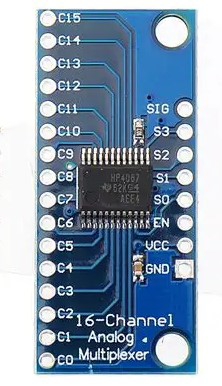
 Design with 16 - Channel Analog Multiplexer in Cirkit Designer
Design with 16 - Channel Analog Multiplexer in Cirkit DesignerIntroduction
The 16-Channel Analog Multiplexer (Manufacturer: tyuyu, Part ID: yt7i8) is a versatile electronic component designed to route one of 16 analog input signals to a single output channel. This device is controlled using digital selection signals, making it ideal for applications requiring efficient signal routing and switching.
Explore Projects Built with 16 - Channel Analog Multiplexer
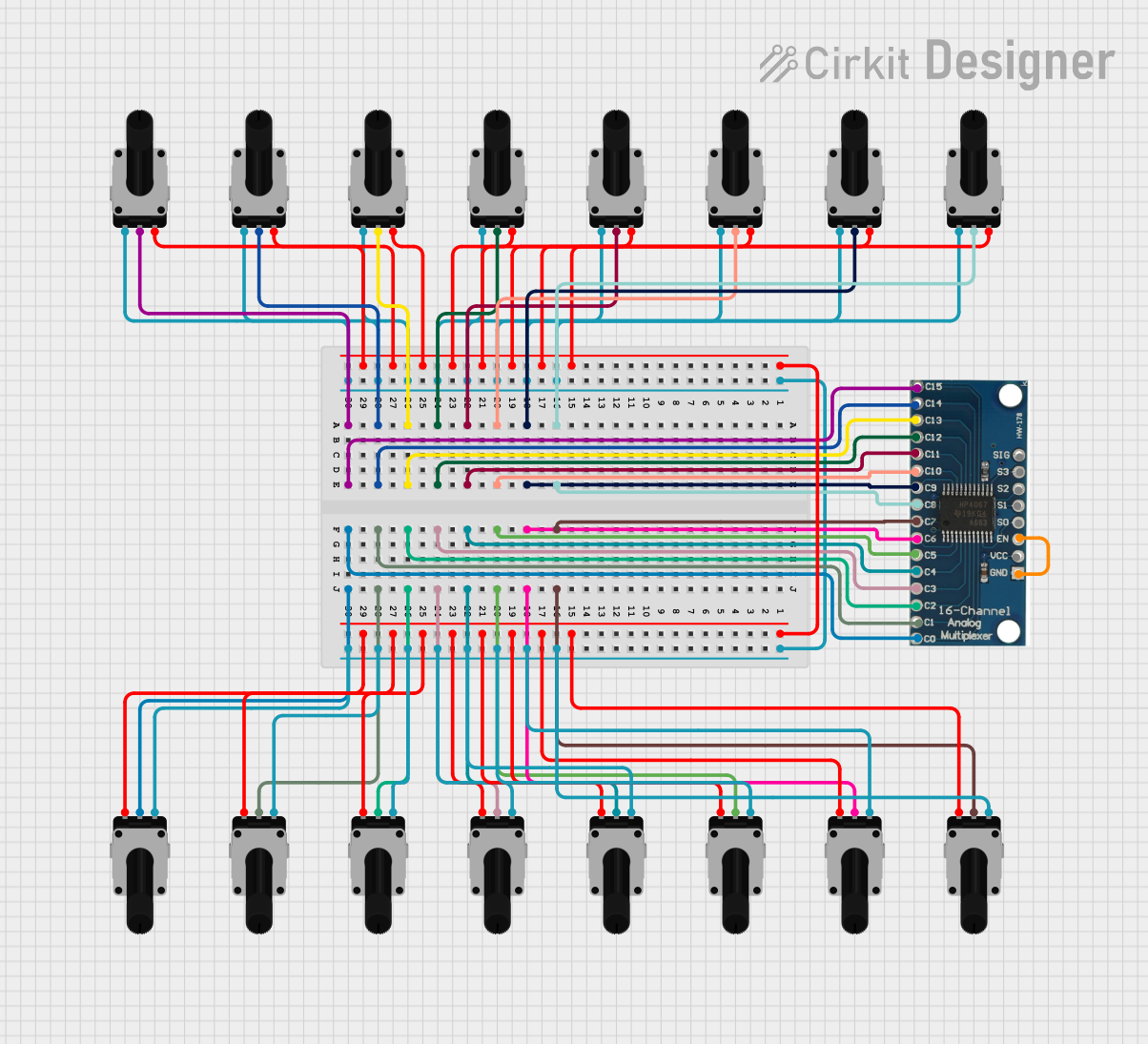
 Open Project in Cirkit Designer
Open Project in Cirkit Designer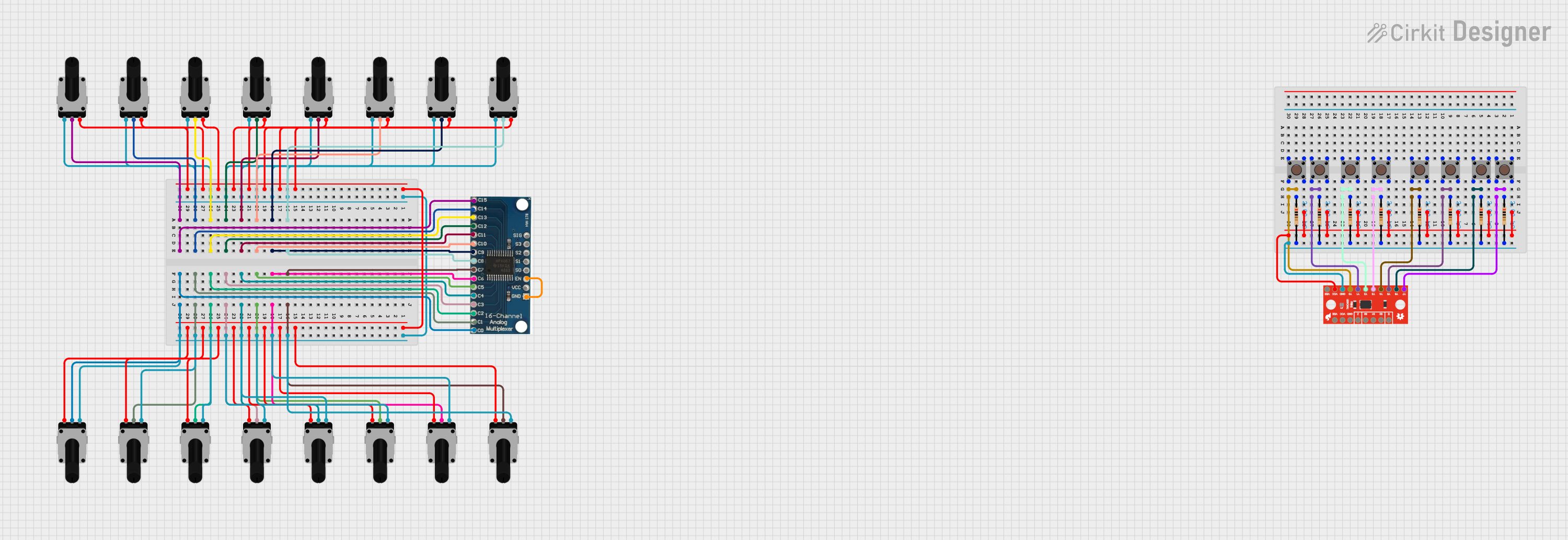
 Open Project in Cirkit Designer
Open Project in Cirkit Designer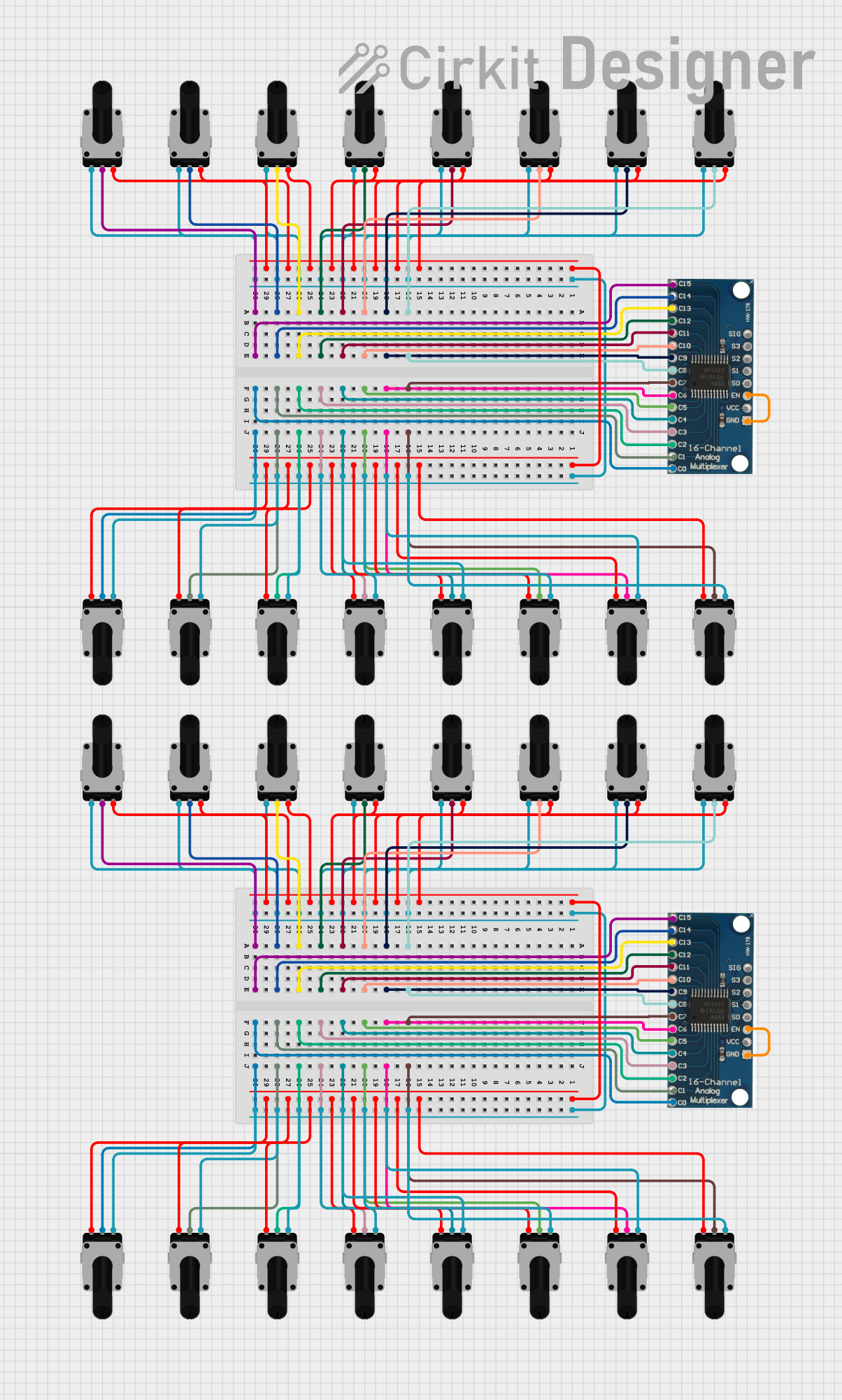
 Open Project in Cirkit Designer
Open Project in Cirkit Designer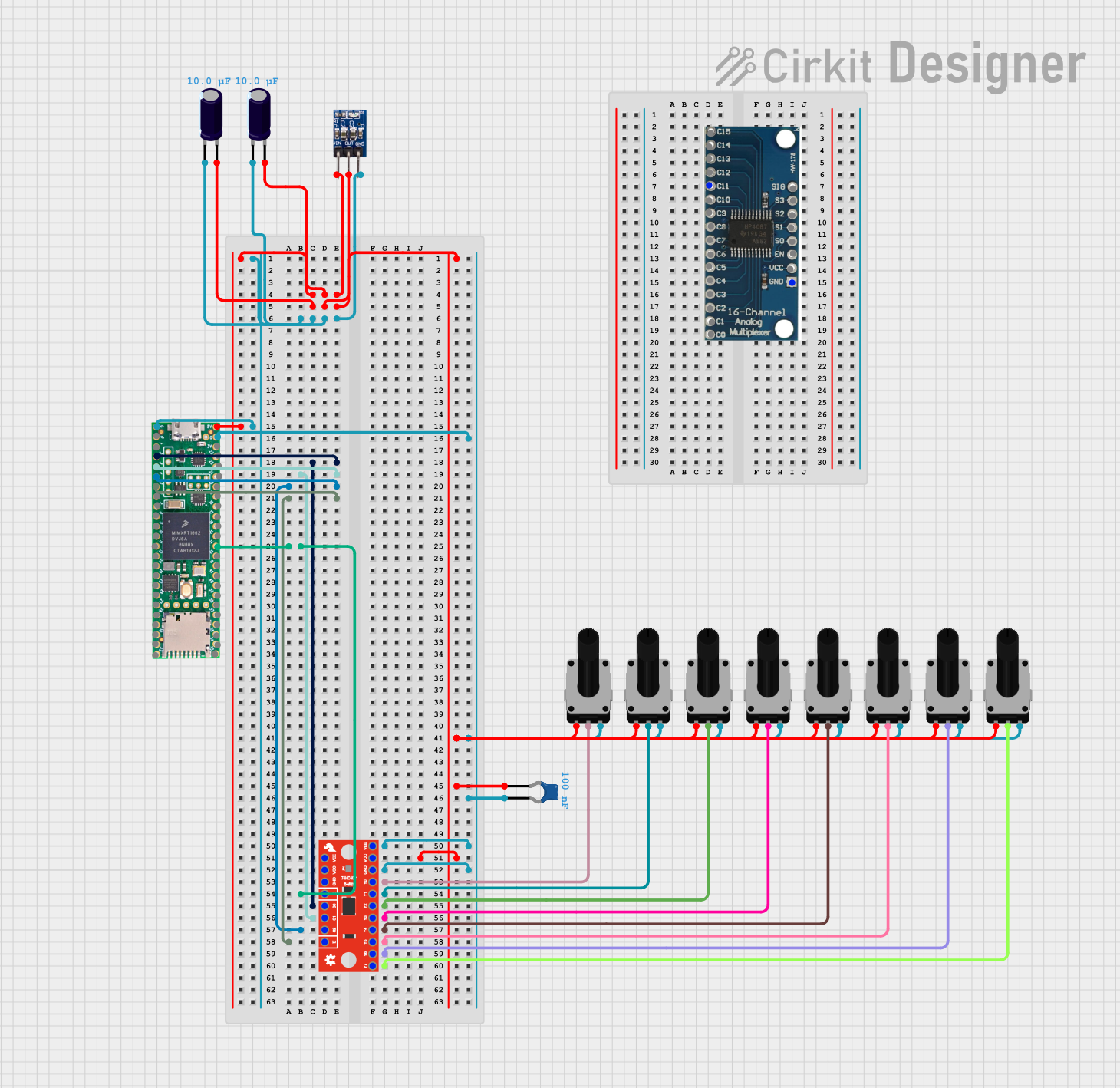
 Open Project in Cirkit Designer
Open Project in Cirkit DesignerExplore Projects Built with 16 - Channel Analog Multiplexer

 Open Project in Cirkit Designer
Open Project in Cirkit Designer
 Open Project in Cirkit Designer
Open Project in Cirkit Designer
 Open Project in Cirkit Designer
Open Project in Cirkit Designer
 Open Project in Cirkit Designer
Open Project in Cirkit DesignerCommon Applications and Use Cases
- Signal selection in data acquisition systems
- Expanding the number of analog inputs for microcontrollers
- Audio signal routing and mixing
- Sensor multiplexing in IoT devices
- Test and measurement equipment
Technical Specifications
The following table outlines the key technical details of the yt7i8 16-Channel Analog Multiplexer:
| Parameter | Value |
|---|---|
| Supply Voltage (Vcc) | 3V to 15V |
| Analog Input Voltage | 0V to Vcc |
| Control Logic Voltage | 0V to Vcc |
| On-Resistance (Ron) | ~70Ω (typical) |
| Propagation Delay | ~10ns |
| Maximum Current (Icc) | 1µA (standby), 1mA (active) |
| Operating Temperature | -40°C to +85°C |
| Package Type | DIP, SOIC |
Pin Configuration and Descriptions
The yt7i8 multiplexer has 16 input channels, 1 output channel, 4 control pins, and additional power and ground pins. Below is the pinout description:
| Pin Number | Pin Name | Description |
|---|---|---|
| 1-16 | IN0-IN15 | Analog input channels (0 to 15) |
| 17 | OUT | Analog output channel |
| 18 | Vcc | Positive power supply |
| 19 | GND | Ground |
| 20-23 | S0-S3 | Control pins for channel selection (binary encoded) |
| 24 | ENABLE | Active-low enable pin (must be LOW to operate) |
Usage Instructions
How to Use the Component in a Circuit
- Power Supply: Connect the Vcc pin to a stable power source (3V to 15V) and the GND pin to ground.
- Input Signals: Connect up to 16 analog signals to the IN0-IN15 pins.
- Output Signal: Connect the OUT pin to the desired destination (e.g., ADC input of a microcontroller).
- Control Signals: Use the S0-S3 pins to select the desired input channel. The selection is based on a 4-bit binary code:
- For example, to select IN3, set S3-S0 to
0011.
- For example, to select IN3, set S3-S0 to
- Enable Pin: Ensure the ENABLE pin is pulled LOW to activate the multiplexer. If HIGH, the device is disabled, and the output is disconnected.
Important Considerations and Best Practices
- Input Voltage Range: Ensure that the input signals do not exceed the supply voltage (Vcc).
- Decoupling Capacitor: Place a 0.1µF capacitor near the Vcc pin to reduce noise and stabilize the power supply.
- Unused Inputs: Tie unused input channels to ground or a fixed voltage to prevent floating inputs, which can cause noise.
- Control Signal Timing: Ensure that the control signals are stable before enabling the multiplexer to avoid glitches.
Example: Connecting to an Arduino UNO
Below is an example of how to use the yt7i8 multiplexer with an Arduino UNO to read multiple analog signals:
Circuit Connections
- Connect Vcc to the Arduino's 5V pin and GND to ground.
- Connect OUT to the Arduino's A0 pin.
- Connect S0-S3 to Arduino digital pins 2, 3, 4, and 5, respectively.
- Pull the ENABLE pin LOW by connecting it to ground.
Arduino Code
// Define control pins for the multiplexer
const int S0 = 2; // Control pin S0
const int S1 = 3; // Control pin S1
const int S2 = 4; // Control pin S2
const int S3 = 5; // Control pin S3
const int analogOut = A0; // Multiplexer output connected to A0
void setup() {
// Set control pins as outputs
pinMode(S0, OUTPUT);
pinMode(S1, OUTPUT);
pinMode(S2, OUTPUT);
pinMode(S3, OUTPUT);
// Initialize serial communication for debugging
Serial.begin(9600);
}
void loop() {
for (int channel = 0; channel < 16; channel++) {
// Set the control pins to select the desired channel
digitalWrite(S0, channel & 0x01); // Least significant bit
digitalWrite(S1, (channel >> 1) & 0x01);
digitalWrite(S2, (channel >> 2) & 0x01);
digitalWrite(S3, (channel >> 3) & 0x01);
// Read the analog value from the selected channel
int value = analogRead(analogOut);
// Print the channel number and value to the serial monitor
Serial.print("Channel ");
Serial.print(channel);
Serial.print(": ");
Serial.println(value);
delay(500); // Wait for 500ms before switching to the next channel
}
}
Troubleshooting and FAQs
Common Issues and Solutions
No Output Signal:
- Ensure the ENABLE pin is LOW.
- Verify that the control signals (S0-S3) are correctly set for the desired channel.
- Check the power supply connections to Vcc and GND.
Incorrect or Noisy Output:
- Ensure the input signals are within the specified voltage range (0V to Vcc).
- Add a decoupling capacitor near the power supply pins to reduce noise.
- Avoid long wires for analog signals to minimize interference.
Floating Inputs:
- Tie unused input channels to ground or a fixed voltage to prevent noise.
FAQs
Q1: Can the multiplexer handle digital signals?
A1: Yes, the yt7i8 can route digital signals as long as they are within the specified voltage range.
Q2: What happens if the ENABLE pin is left floating?
A2: The ENABLE pin must be explicitly set to LOW for the multiplexer to function. If left floating, the behavior is undefined.
Q3: Can I cascade multiple multiplexers to handle more channels?
A3: Yes, you can cascade multiple multiplexers by connecting their outputs to additional multiplexers or microcontroller inputs. Ensure proper control signal management.
Q4: What is the maximum switching speed?
A4: The yt7i8 has a typical propagation delay of ~10ns, making it suitable for high-speed applications. However, the actual switching speed depends on the control signal timing.